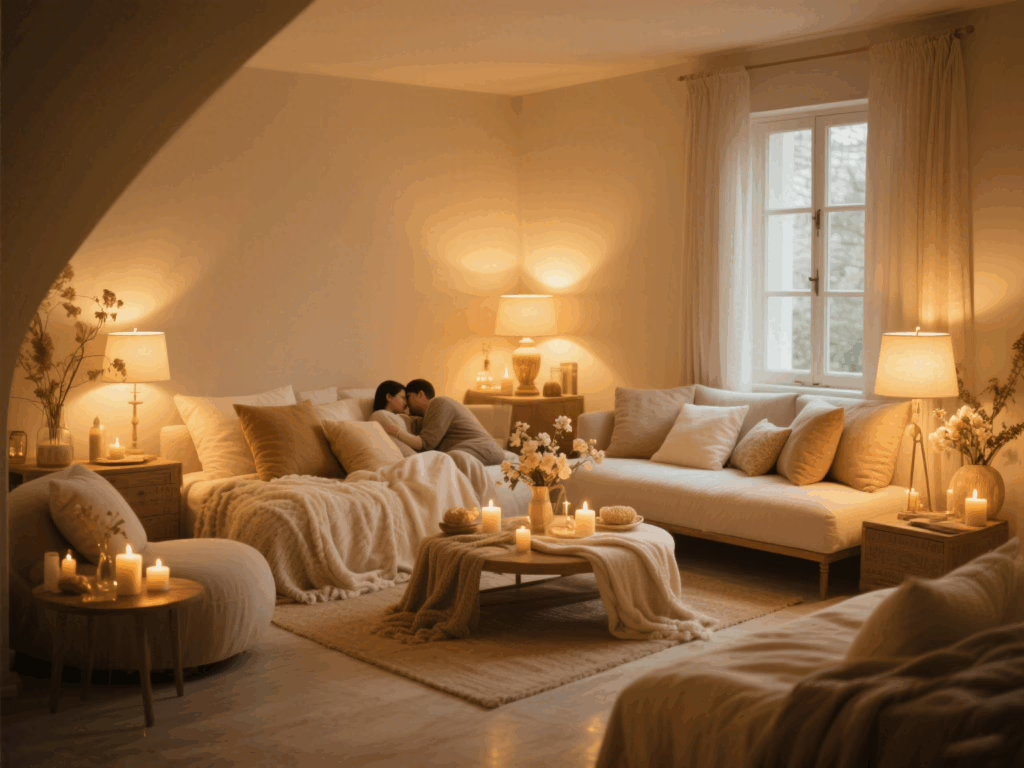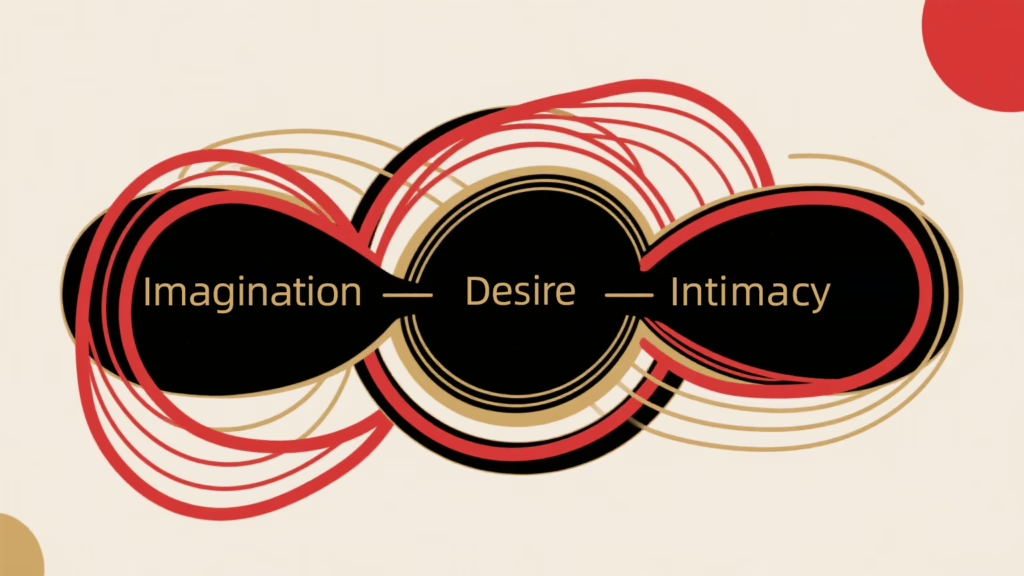Introduction
In our digital age of constant distractions and rushing through life, we often forget the power of truly experiencing each moment through our senses. When it comes to romantic intimacy, engaging all five senses can transform ordinary encounters into extraordinary memories that strengthen your emotional and physical connection with your partner.
Sensory intimacy goes beyond the basic physical aspects of romance—it’s about creating a complete sensory experience that engages your partner’s mind, body, and emotions simultaneously. Research in neuroscience shows that multisensory experiences create stronger neural pathways and more vivid memories, making sensory-rich intimate moments more satisfying and memorable for both partners.

Whether you’re in a new relationship looking to deepen your connection or a long-term couple seeking to reignite passion, understanding how to thoughtfully engage each sense can create experiences that satisfy on multiple levels. The techniques we’ll explore are backed by sensory psychology research and designed to create lasting impressions that extend far beyond a single evening.
This comprehensive guide will take you through each of the five senses, providing practical ideas, scientific insights, and creative suggestions for incorporating sensory play into your romantic life in ways that feel natural, exciting, and deeply connecting.
The Science Behind Sensory Intimacy
How Our Senses Shape Memory and Connection
Neuroscientist research reveals that our five senses don’t operate in isolation—they work together to create what scientists call “multisensory integration.” When multiple senses are engaged simultaneously, the brain creates richer, more detailed memories and experiences more intense emotional responses.
In romantic contexts, this multisensory integration explains why certain scents can instantly transport us back to meaningful moments with our partners, why a particular song can recreate the emotional intensity of a special evening, or why specific textures can trigger profound feelings of connection and desire.

The Neurochemistry of Sensory Pleasure
When we experience pleasurable sensory stimulation, our brains release a cascade of neurochemicals including dopamine (associated with reward and motivation), oxytocin (the bonding hormone), and endorphins (natural feel-good chemicals). These neurochemical responses are amplified when multiple senses are engaged simultaneously, creating more intense feelings of pleasure, connection, and bonding with our partners.
Understanding this science helps us appreciate why sensory intimacy isn’t just about immediate pleasure—it’s about creating neurochemical conditions that strengthen our emotional bonds and create positive associations with our partners that last long after the sensory experience ends.
Sight: Creating Visual Magic for Romance
The Psychology of Visual Stimulation
Vision is often considered our dominant sense, processing about 80% of the information we receive about our environment. In romantic contexts, visual stimulation can set the mood, communicate desire, and create anticipation before any physical contact occurs.
Research in environmental psychology shows that lighting, color, and visual arrangement significantly impact mood, arousal levels, and emotional comfort. By thoughtfully designing visual experiences, you can create environments that naturally enhance intimacy and connection.
Lighting: The Foundation of Visual Romance
Candlelight Magic: Candles create warm, flickering light that naturally softens features and creates an intimate atmosphere. The specific wavelength of candlelight (around 1900K) promotes relaxation and reduces cortisol levels while creating a sense of timelessness and escape from daily stresses.
Strategic Lamp Placement: Use table lamps or floor lamps with warm bulbs (2700K-3000K) positioned at different heights to create layers of light. Avoid overhead lighting, which can feel harsh and clinical. Instead, create pools of warm light that invite closeness and intimacy.
Natural Light Transitions: If beginning your evening during daylight hours, pay attention to how natural light changes throughout the evening. Position yourselves near windows where you can watch the sunset together, allowing the natural transition from daylight to darkness to create a sense of time suspended.

Color Psychology in Romance
Warm Color Palettes: Reds, oranges, and deep pinks stimulate energy and passion while creating feelings of warmth and connection. These colors increase heart rate slightly and promote feelings of excitement and intimacy.
Rich Jewel Tones: Deep purples, burgundy, and emerald green create feelings of luxury and sensuality while maintaining sophistication. These colors are associated with depth, mystery, and richness of experience.
Soft Neutrals with Warm Undertones: Cream, champagne, and soft gold create elegant, timeless atmospheres that feel both luxurious and comfortable. These colors provide a sophisticated backdrop that allows other sensory elements to shine.
Visual Texture and Movement
Fabric and Textiles: Introduce visual interest through varied fabrics—silk, velvet, faux fur, or flowing chiffon. These materials catch light differently and create visual depth while hinting at the tactile experiences to come.
Fresh Flowers and Natural Elements: Fresh flowers, particularly roses, peonies, or orchids, add natural beauty and create visual focal points. The organic shapes and natural colors of flowers provide a softening contrast to geometric room elements.
Mirror Placement: Strategically placed mirrors can create interesting visual dimensions and allow partners to see themselves and each other from different angles, adding visual interest and expanding the sense of space.
Sound: Crafting the Perfect Audio Landscape
The Power of Auditory Intimacy
Sound directly affects our nervous system and emotional state. Research shows that certain frequencies and rhythms can synchronize heart rates between partners, create relaxation responses, and even influence hormone production. The auditory environment you create can either enhance or detract from intimate connection, making sound one of the most important yet often overlooked aspects of sensory intimacy.
Music Selection for Different Moods
Classical and Instrumental: Pieces like Debussy’s “Clair de Lune” or Bach’s “Air on G String” create sophisticated, timeless atmospheres. Classical music has been shown to reduce stress hormones and create feelings of elevation and transcendence.
Jazz and Blues: Smooth jazz, particularly pieces with saxophone or piano, creates sophisticated, sultry atmospheres. The improvisational nature of jazz mirrors the spontaneous, responsive nature of intimate connection.
World Music: Incorporate sounds from different cultures—Spanish guitar, Indian sitar, or African drums—to create exotic, adventurous atmospheres that transport you both to different emotional and imaginative spaces.
Nature Sounds: Ocean waves, gentle rain, or forest sounds can create deeply relaxing environments that help partners disconnect from daily stresses and connect with more primal, natural rhythms.

The Importance of Silence and Natural Sounds
Strategic Silence: Planned moments of silence allow partners to focus on other senses and create anticipation. Silence also allows natural sounds—breathing, heartbeats, gentle movements—to become part of the sensory experience.
Whispered Communication: Speaking in whispers or very soft tones creates intimacy and requires closer physical proximity. The effort required to hear soft sounds increases attention and presence.
Natural Body Sounds: Rather than masking natural sounds, embrace them as part of the intimate experience. The sound of breathing, gentle sighs, or heartbeats can be incredibly intimate and connecting.
Technology and Sound Control
Wireless Speakers: Invest in quality wireless speakers that can be placed around the room to create surround sound without visible wires disrupting the aesthetic. Many modern speakers offer warm, rich sound quality that enhances rather than dominates the sensory experience.
Sound Apps and Playlists: Create carefully curated playlists for different moods and phases of your evening. Consider apps that offer high-quality nature sounds, binaural beats, or meditation music specifically designed for relaxation and connection.
Volume and Dynamics: Keep music at a volume that enhances rather than overwhelms. The music should create atmosphere without requiring you to speak louder or compete with it for attention.
Scent: Unleashing the Power of Aromatherapy
The Direct Path to Emotion and Memory
The olfactory system has a direct connection to the limbic system—the part of the brain responsible for emotion and memory formation. This unique neural pathway means that scents can trigger immediate emotional responses and create powerful associations that last for years.
In romantic contexts, scent can create instant mood changes, trigger positive memories, and even influence hormone production. Understanding how to use scent strategically can dramatically enhance the emotional and physical impact of intimate experiences.
Natural vs. Synthetic Scents
Essential Oils: Pure essential oils offer complex, natural fragrances that change and develop over time. Unlike synthetic fragrances, essential oils contain multiple aromatic compounds that create depth and complexity.
Personal Body Chemistry: Natural scents interact with individual body chemistry to create unique fragrances. This personal element makes natural scents more intimate and individualized than synthetic alternatives.
Quality Considerations: Invest in high-quality essential oils or natural fragrances. Synthetic or low-quality scents can feel overwhelming or artificial, while pure, natural scents feel more luxurious and sophisticated.
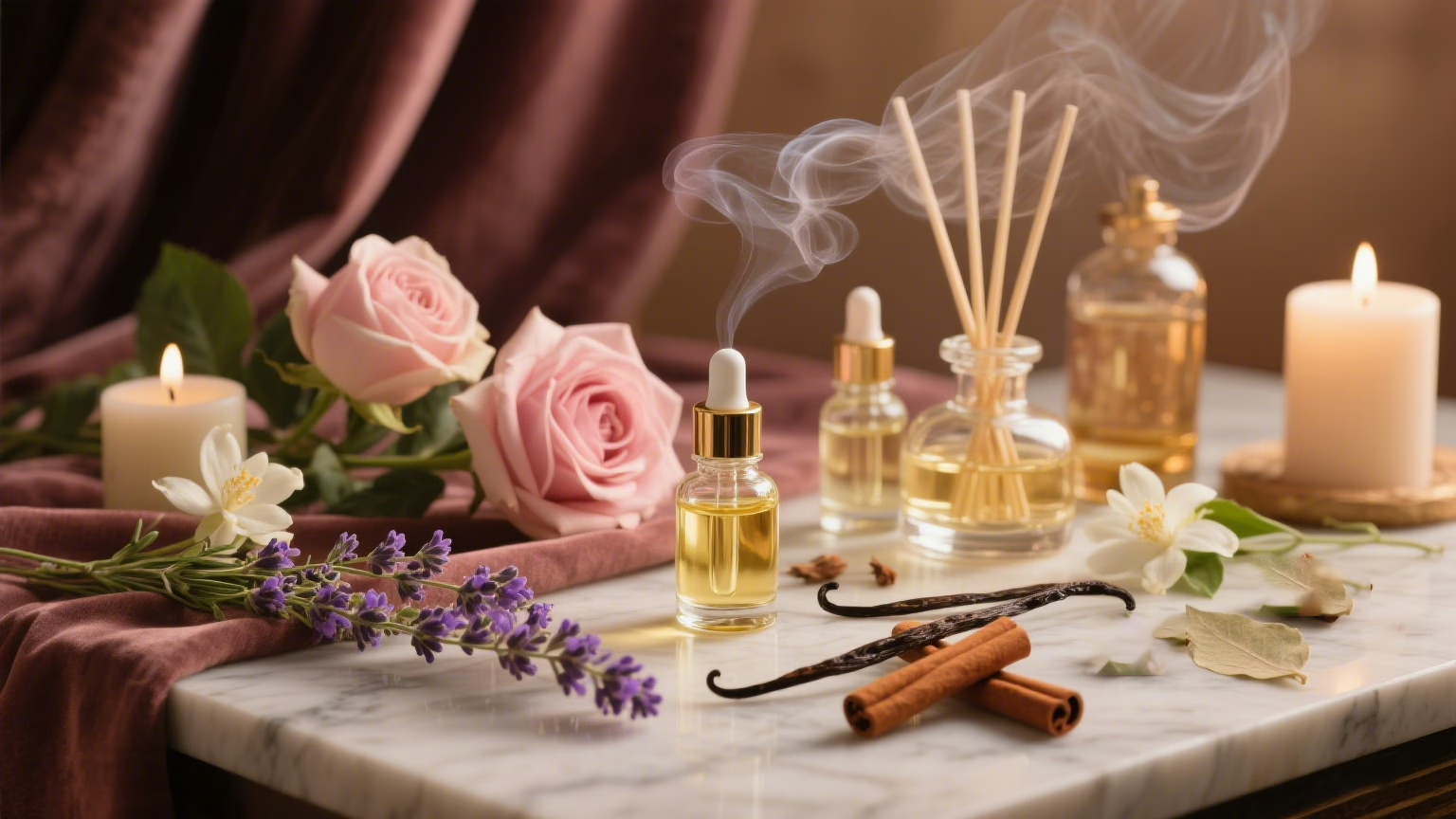
Aphrodisiac Scents and Their Effects
Rose: Often called the queen of essential oils, rose scent has been scientifically shown to reduce cortisol levels and increase feelings of love and emotional openness. Rose also has a complex, multilayered fragrance that develops over time.
Jasmine: This exotic floral scent is known for its mood-elevating properties and its ability to increase confidence and reduce inhibitions. Jasmine blooms at night, making it particularly appropriate for evening romance.
Sandalwood: With its warm, woody base notes, sandalwood creates feelings of grounding and sensuality. It’s particularly appealing to many people and has been used in romantic contexts across cultures for centuries.
Vanilla: The sweet, comforting scent of vanilla increases feelings of warmth and comfort while reducing stress. Studies show that vanilla scent can increase feelings of joy and relaxation.
Ylang-Ylang: This tropical floral scent is known for its ability to reduce anxiety and create feelings of euphoria. It’s often used in perfumery for its exotic, sensual qualities.
Scent Application Methods
Diffusion: Use ultrasonic diffusers to disperse essential oils evenly throughout your space. This method allows for subtle, consistent fragrance that doesn’t overwhelm.
Topical Application: When properly diluted, certain essential oils can be applied to pulse points—wrists, neck, behind ears—where body heat will naturally diffuse the scent.
Scented Fabrics: Add drops of essential oil to pillowcases, curtains, or throws hours before your evening together. This creates subtle, discovering scents as you move through the space.
Bath Integration: Add essential oils to bathwater (properly diluted with a carrier oil) to create full-body scent immersion while also benefiting from aromatherapy during relaxation.
Taste: Exploring Culinary Sensuality
The Intimate Nature of Sharing Food
Sharing food and drink creates unique intimacy—it requires trust, involves nourishing each other, and engages multiple senses simultaneously. The act of feeding someone or being fed triggers nurturing instincts and creates physical closeness that naturally leads to emotional connection.
Research in social psychology shows that sharing meals increases cooperation, empathy, and bonding between individuals. In romantic contexts, thoughtfully chosen foods and drinks can enhance mood, create playful interactions, and provide opportunities for creative, sensual experiences.
Aphrodisiac Foods and Their Properties
Dark Chocolate: Contains phenylethylamine and serotonin, natural compounds that promote feelings of pleasure and attraction. The rich, complex flavor of high-quality dark chocolate creates sensual eating experiences and releases endorphins.
Fresh Strawberries: The combination of sweet flavor, juicy texture, and natural fragrance makes strawberries naturally sensual. They’re also high in vitamin C, which supports energy and vitality.
Figs: With their unique texture and mildly sweet flavor, fresh figs have been considered aphrodisiacs since ancient times. Their sensual eating experience and exotic nature make them perfect for romantic sharing.
Champagne or Quality Wine: Alcohol in moderation can reduce inhibitions and create feelings of celebration and luxury. The effervescence of champagne adds a playful, festive element to romantic encounters.

Interactive Feeding Experiences
Hand-Feeding: Taking turns feeding each other creates physical closeness, eye contact, and playful interaction. Choose foods that are easy to eat by hand and won’t create mess or distraction.
Wine or Champagne Tasting: Create mini-tasting experiences where you describe flavors, share impressions, and discover preferences together. The focused attention on taste creates mindfulness and shared experience.
Cooking Together: Prepare simple foods together—chocolate-covered strawberries, fruit salads, or cheese and wine pairings. The collaborative process creates connection while building anticipation for the tasting experience.
Temperature Play with Food
Warm and Cool Contrasts: Alternate between warm beverages (spiced wine, hot chocolate) and cool treats (chilled fruits, ice cream) to create interesting temperature sensations and heightened awareness of taste and texture.
Ice Integration: Use ice cubes flavored with fruits or herbs to create cooling sensations and unique flavors. The temperature contrast creates heightened sensory awareness.
Warm Oil Tastings: Warm, edible oils infused with herbs or spices can be used for both tasting and massage, creating multisensory experiences that blend taste and touch.
Touch: The Foundation of Physical Connection
Understanding the Psychology of Touch
Touch is our first sense to develop and arguably the most important for emotional bonding and physical intimacy. Different types of touch trigger different neurological responses—some calming and soothing, others energizing and arousing. Understanding these different touch responses allows you to create varied, dynamic tactile experiences.
Research shows that positive touch releases oxytocin, reduces cortisol levels, and can even synchronize heartbeats between partners. The key to great sensory touch experiences is variety, intentionality, and responsiveness to your partner’s reactions.
Texture Exploration
Fabric Varieties: Incorporate different fabric textures—silk scarves for smooth, cooling sensations; velvet for rich, warm touch; faux fur for unique, luxurious texture; or lace for delicate, intricate patterns against skin.
Natural Textures: Use natural elements like smooth stones (warmed or cooled), feathers for gentle tickling sensations, or wooden objects with interesting grains and textures.
Temperature Variations: Experiment with temperature through ice cubes, warm oils, heated towels, or objects that have been warmed or cooled to create surprising and heightened sensations.
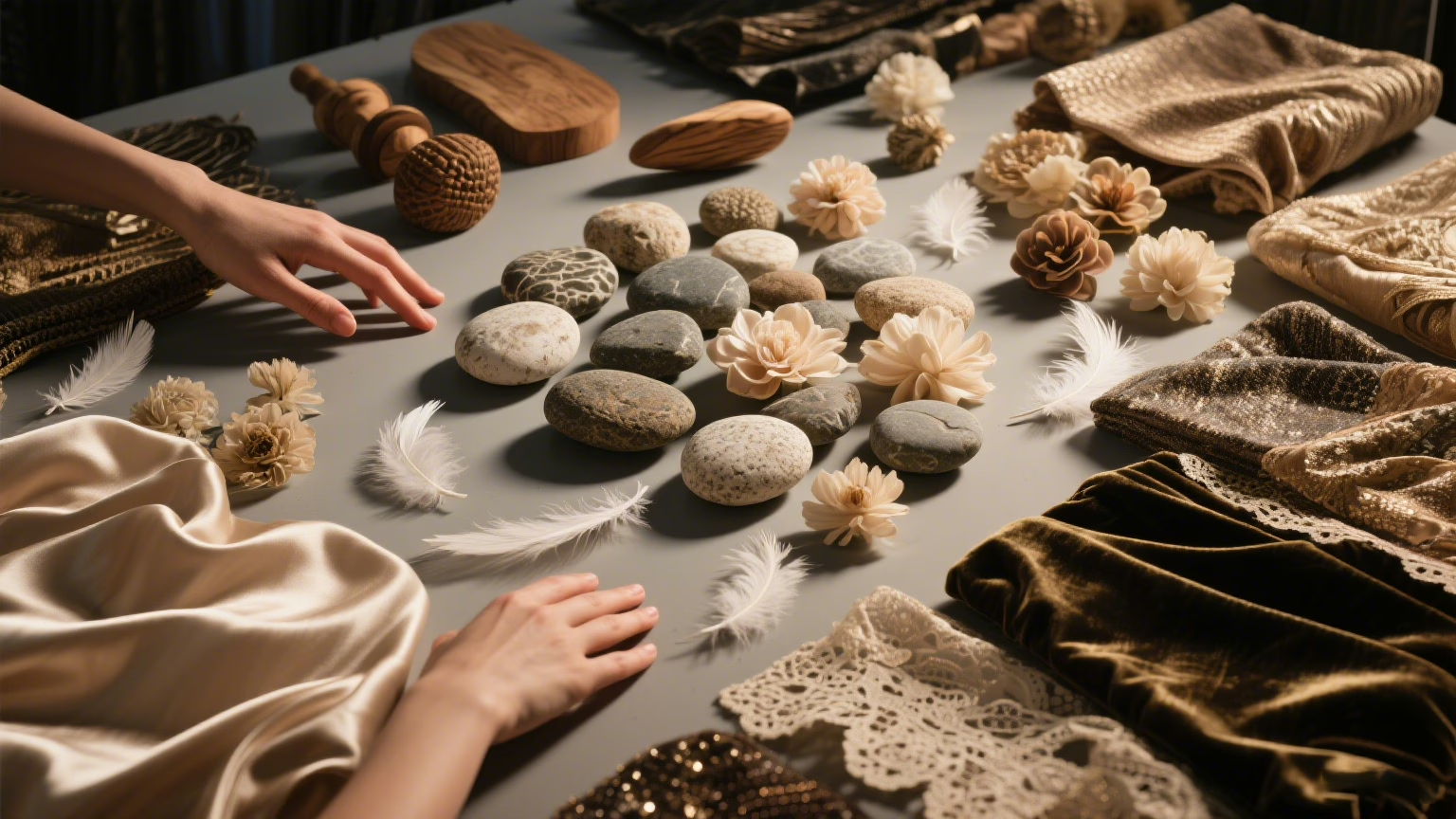
Massage and Touch Techniques
Pressure Variation: Alternate between light, feather-like touches and firmer, more grounding pressure. This variation keeps the nervous system engaged and prevents adaptation to any single sensation.
Rhythm and Pattern: Create rhythmic patterns with your touch—circular motions, long strokes, gentle tapping—that create anticipation and allow your partner to relax into predictable yet pleasurable sensations.
Oil and Lotion Integration: Use high-quality massage oils or lotions with appealing scents and smooth textures. Warm the oil in your hands before application to avoid shocking cool sensations.
Non-Traditional Touch Ideas
Brush and Implement Use: Soft-bristled brushes, silk scarves, or even fresh flower petals can create unique sensations that differ from hand touch while maintaining intimacy and connection.
Water Integration: Incorporate water through shared baths, warm washcloths, or gentle water pouring to create soothing, cleansing, and refreshing touch experiences.
Contrast Play: Alternate between different types of touch—rough and smooth, warm and cool, firm and gentle—to keep sensations interesting and prevent habituation.
Integrating All Five Senses: Creating Complete Experiences
The Synergy Effect
When all five senses are engaged thoughtfully and simultaneously, they create what psychologists call a “synergy effect”—the combined impact is greater than the sum of individual sensory experiences. This integration creates more intense, memorable, and emotionally significant experiences.
The key to successful multisensory integration is avoiding sensory overload while ensuring each sense contributes meaningfully to the overall experience. This requires planning, attention to detail, and responsiveness to your partner’s reactions and preferences.

Creating Sensory Journeys
Progressive Revelation: Start with one or two senses and gradually introduce others throughout your evening together. This creates a sense of unfolding discovery and prevents initial overwhelm.
Themed Experiences: Create consistent themes across all senses—for example, a “tropical paradise” theme might include tropical fruits, island music, floral scents, warm lighting, and lightweight, flowing fabrics.
Seasonal Integration: Adapt your sensory experiences to seasons—warm spices and rich textures for winter, light florals and cooling elements for summer—to create experiences that feel natural and timely.
Timing and Pacing
Natural Rhythms: Pay attention to natural energy rhythms throughout your evening. Some sensory experiences are energizing (citrus scents, upbeat music) while others are calming (lavender, soft lighting). Sequence experiences to support natural energy flows.
Pause and Savoring: Build in moments for pausing and fully experiencing each sensory element. The goal isn’t to rush through all five senses quickly, but to create space for deep appreciation of each experience.
Responsiveness: Stay attuned to your partner’s responses and be willing to adjust the sensory experience based on their reactions and preferences. The best sensory experiences are collaborative and responsive.
Practical Planning for Sensory Evenings
Preparation and Setup
Advance Planning: Great sensory experiences require some advance preparation. Plan your music playlist, prepare scent diffusion, arrange lighting, select foods and drinks, and gather tactile elements hours or even days before your planned evening.
Space Preparation: Create a dedicated space free from distractions—phones silenced, clutter cleared, comfortable temperature maintained. The environment should feel special and separate from daily life.
Backup Plans: Have alternatives ready in case something doesn’t work as planned. If a scent is too strong, have lighter options. If music feels wrong for the moment, have different playlists ready.
Budget-Friendly Options
Natural Elements: Many effective sensory elements are free or inexpensive—flower petals, interesting stones, natural lighting from sunset, homemade playlists, simple foods prepared with care.
DIY Approaches: Create your own massage oils by mixing carrier oils with a few drops of essential oils. Make playlists from streaming services. Use items you already own in new, creative ways.
Quality over Quantity: Focus on one or two high-quality sensory elements rather than many mediocre ones. A single excellent wine, one beautiful candle, or one perfect playlist can be more impactful than many lesser elements.
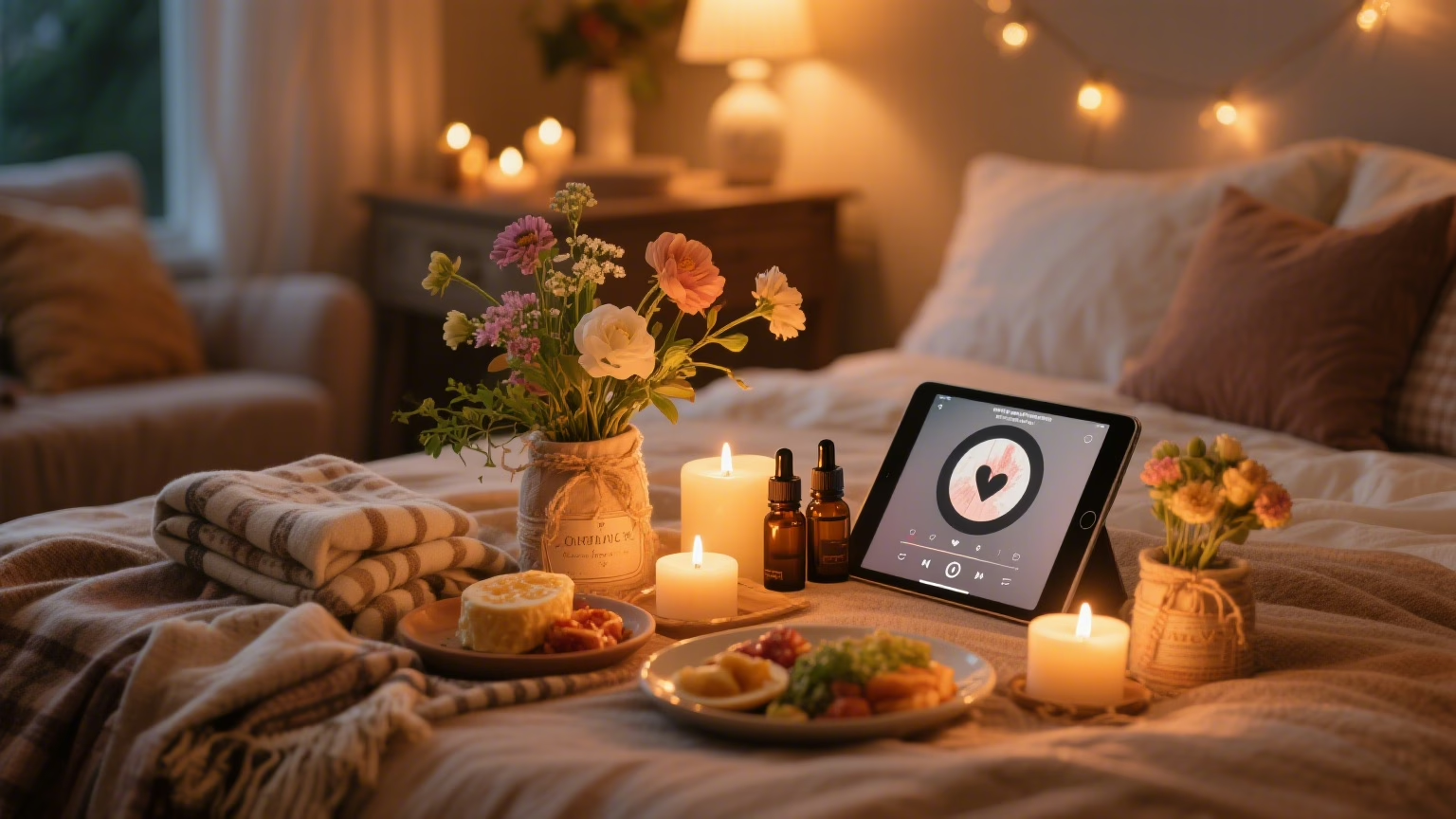
Communication and Consent in Sensory Play
Discussing Preferences and Boundaries
Open Conversation: Before incorporating sensory play, discuss preferences, boundaries, and any sensitivities. Some people have strong reactions to certain scents, sounds, or textures that could detract from the experience.
Gradual Introduction: Introduce new sensory elements gradually, checking for reactions and preferences before fully incorporating them into intimate experiences.
Safe Words and Signals: Establish clear communication methods for indicating when something feels good, needs adjustment, or should stop entirely. This allows both partners to relax and enjoy the experience.
Adapting for Different Sensitivities
Sensory Processing Differences: Some individuals have heightened sensitivity to certain sensory inputs or conditions like synesthesia that affect how they experience multiple senses. Understanding and adapting to these differences creates more inclusive and enjoyable experiences.
Allergy Considerations: Be aware of potential allergies to foods, scents, or materials. Always test new elements in small amounts before full integration into intimate experiences.
Personal History: Respect that some individuals may have negative associations with certain sensory experiences. Creating safe spaces for sharing these concerns allows for better customization of sensory experiences.
Long-Term Benefits of Sensory Intimacy
Strengthening Emotional Bonds
Regular engagement in thoughtful sensory experiences creates positive associations, shared memories, and deeper emotional connections between partners. These experiences become part of your relationship’s unique history and create reference points for future connection.
Enhanced Mindfulness and Presence
Sensory focus naturally creates mindfulness—awareness of the present moment without judgment. This mindfulness practice, when shared with a partner, strengthens your ability to be present and connected in all aspects of your relationship.
Improved Communication Skills
Planning and experiencing sensory intimacy requires communication about preferences, reactions, and desires. These communication skills transfer to other aspects of the relationship, creating better overall connection and understanding.

Seasonal Adaptations for Year-Round Sensory Romance
Spring Sensory Themes
Fresh and Renewing: Incorporate light floral scents like lilac or cherry blossom, fresh fruits like strawberries and early berries, light, airy fabrics, and music that feels fresh and energizing. Take advantage of longer daylight and mild temperatures for new experiences.
Summer Sensory Approaches
Cooling and Refreshing: Use cooling elements like chilled fruits, ice play, lighter scents like citrus or mint, flowing fabrics, and music that feels relaxed and vacation-like. Take advantage of warm evenings for outdoor sensory experiences.
Fall Sensory Integration
Warming and Grounding: Incorporate warming spices like cinnamon and vanilla, richer foods like wine and chocolate, warmer lighting, cozy textures like wool or flannel, and music that feels intimate and contemplative.
Winter Sensory Experiences
Luxurious and Indulgent: Use rich, warming scents like sandalwood or amber, indulgent foods and drinks, multiple layers of lighting for long, dark evenings, luxurious textures like velvet and faux fur, and music that feels elegant and timeless.
Troubleshooting Common Challenges
When Sensory Elements Don’t Work
Over-Stimulation: If the experience feels overwhelming, simplify by focusing on fewer senses or reducing intensity of sensory inputs. Sometimes less is more for creating meaningful connection.
Competing Elements: If different sensory elements seem to conflict with each other, prioritize the ones that are working best and eliminate or adjust the conflicting elements.
Partner Preferences: If partners have very different sensory preferences, find compromise approaches or take turns focusing on each person’s preferred sensory experiences.
Maintaining Spontaneity
Prepared Spontaneity: Keep some sensory elements readily available—candles, essential oils, good playlists—so you can create sensory experiences without extensive advance planning.
Seasonal Adaptation: Adjust your available sensory elements based on seasons and circumstances, maintaining variety and interest over time.
Learning and Growth: Continuously experiment with new sensory elements and combinations, treating sensory intimacy as an ongoing exploration rather than a fixed routine.
Conclusion
Creating unforgettable nights through sensory intimacy is both an art and a science. By understanding how our five senses interact to create memory, emotion, and connection, couples can design experiences that satisfy on multiple levels and create lasting positive associations.
The techniques and approaches outlined in this guide provide a foundation for sensory exploration, but the most important element is the intention to create meaningful, connecting experiences with your partner. Whether you incorporate all five senses elaborate or focus on just one or two elements, the key is thoughtfulness, communication, and responsiveness to each other’s needs and preferences.
Remember that great sensory experiences don’t require expensive purchases or elaborate setups. Some of the most memorable intimate moments come from simple elements combined with creativity, attention, and genuine care for your partner’s experience and pleasure.
Start with the sensory elements that feel most natural and appealing to you, and gradually expand your repertoire as you discover what works best for your unique relationship. The journey of sensory exploration can be just as rewarding as any individual experience, creating opportunities for ongoing discovery, communication, and deepening connection.
Your investment in creating rich, multisensory intimate experiences will pay dividends not just in immediate pleasure and connection, but in the lasting memories and positive associations that strengthen your relationship over time. Every sense engaged thoughtfully is an opportunity to show care, create beauty, and build the kind of intimate experiences that become treasured memories for years to come.

